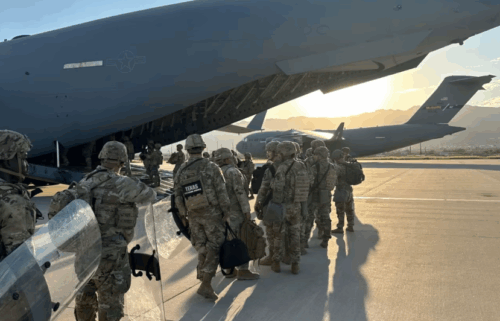Why we’re grateful for the tiny Ingenuity helicopter on Mars
By Ashley Strickland, CNN
This year, we’ve watched the story of a little chopper unfold on another planet. And much like the joy brought by the successful landing of the Perseverance rover on Mars in February, the journey of its Ingenuity helicopter sidekick is just what we needed in 2021.
From millions of miles away, we’ve looked to the red planet as a distraction from our woes as we live through the second year of a pandemic. Meanwhile, two robots are achieving what was once thought to be impossible on Mars.
It’s easy to project our hopes on them, envision them as two robot pals playing out some buddy cop scenario. Their discoveries bring us wonder. Their successes are worth celebrating. And they send back stunning postcards from a rust-colored world.
Ingenuity was built and is powered by the same human trait from which it takes its name. Thousands of dedicated, hardworking and creative people worked for years to make it a reality. When I ask scientists if they ever imagined a helicopter flying on Mars, most of them say no — but they are glad, and in awe, that it exists and is actively flying through the Martian atmosphere.
The journey hasn’t been easy for the helicopter. Imagine building an experiment, technology to be demonstrated on another planet, and not running into some problems. Time and time again, the chopper and its team have overcome these issues to keep exploring.
Perseverance, which is about the size of an SUV, was built to survive for at least two years on Mars; Ingenuity was not. The 4-pound (1.8-kilogram) helicopter was designed for five experimental test flights in April.
To date, Ingenuity has achieved an astonishing 15 flights, and it hasn’t abandoned Perseverance yet. Together, they are exploring Mars in an unprecedented way that could reveal if life ever existed on the red planet. Ingenuity has been the perfect travel companion, scouting ahead and leading the way. And Perseverance doesn’t have to make the journey alone.
Surviving Mars
As humans, we’re intrigued by flight and exploring Mars, so it’s no surprise that something bringing the two together has captivated people around the globe.
After Perseverance survived the infamous “seven minutes of terror” landing on Mars in February, we waited to hear if Ingenuity had survived the seven-month journey through space as well.
I’ve had the privilege of reporting on the rover at CNN for years; the week of Perseverance landing on Mars was like my Super Bowl or Oscars. In the late evening hours of February 20, I waited, still bowled over by the awe of Perseverance’s success, to see if Ingenuity would send us a message.
The little chopper phoned home, from its safe place tucked within the belly of the rover, to say it was OK. It was another big sigh of relief that week, but Ingenuity’s arduous path was just beginning.
Then, it had to unfold like a butterfly from its chrysalis and detach from the rover and its faithful power supply. Perseverance wouldn’t be able to shield Ingenuity from the frigid nights on Mars any longer. The helicopter would have to do that on its own.
Another sigh of relief came the first time Ingenuity charged itself using its solar panel and withstood the freezing Martian nights, which can dip to negative 130 degrees Fahrenheit (-90 degrees Celsius).
Perseverance and Ingenuity took a selfie together, sitting on the surface of Jezero Crater, as if to say “hey, no big deal, just hanging out at the site of an ancient Martian lake.” The image still makes me smile; it’s one of my favorites from this year.
Then, it was time for Ingenuity to fly. And that didn’t come easily, either. But moments that make history never do.
Achieving first flight
The groundbreaking first flight was originally scheduled for April 11, but plans shifted after a command-sequence issue was discovered when the helicopter went through a system of preflight checks with its software.
On April 19, Ingenuity successfully completed the first powered, controlled flight on another planet and safely landed back on the surface. Images and video taken by the rover, as well as aerial photos from the helicopter’s camera, showed Ingenuity in motion.
My favorite is Ingenuity’s perspective of itself, watching its own shadow boldly crossing the Martian landscape.
The helicopter team celebrated in their control room on Earth, leaping out of their chairs.
“We can now say that human beings have flown a rotorcraft on another planet,” said MiMi Aung, Ingenuity project manager at NASA’s Jet Propulsion Laboratory in Pasadenea, California, that day. “We’ve been talking about our Wright brothers moment on another planet for so long. And now, here it is.”
It’s fitting that the mission carried a piece of history as well. A postage stamp-size piece of muslin fabric that covered one of the wings from the Wright brothers’ Flyer 1 is attached to a cable beneath the helicopter’s solar panel.
That first powered, controlled flight on Earth took place aboard the Flyer near Kitty Hawk, North Carolina, when Orville and Wilbur Wright flew 120 feet (36.6 meters) for 12 seconds in December 1903. History was made when the Wright brothers conducted four separate flights on December 17, 1903, and each one was a little longer than the previous one.
Ingenuity was only supposed to fly in April. But just like the Wright brothers, it didn’t give up.
Since then, Ingenuity has beamed back color images, transitioned from a tech demo to an active scout for the rover, survived a scary flight anomaly, flown through changing atmospheric conditions on Mars and conquered record-breaking flights that are further, faster and more challenging than the last.
From dream to reality
Think about the things in your life that weigh 4 pounds. Perhaps it’s a pet, or a family heirloom.
Then picture holding Ingenuity in your hands. Imagine that you poured years of your life into this object, built it and watched it come to life — only to watch it crash during testing.
But then it became real, part of a mission heading to Mars. And it worked, and it’s still working.
Let us be grateful for people like MiMi Aung and Ingenuity’s chief engineer, Bob Balaram, and the rest of the Ingenuity team at NASA for pushing so hard to make what was once an idea sitting on a shelf a successful reality.
Ingenuity may only be 4 pounds, but it has successfully carried all of our hopes. It has allowed us to dream of successors capable of even more, and Ingenuity’s continued achievements spark the same joy as the landing of Perseverance.
The-CNN-Wire
™ & © 2021 Cable News Network, Inc., a WarnerMedia Company. All rights reserved.




